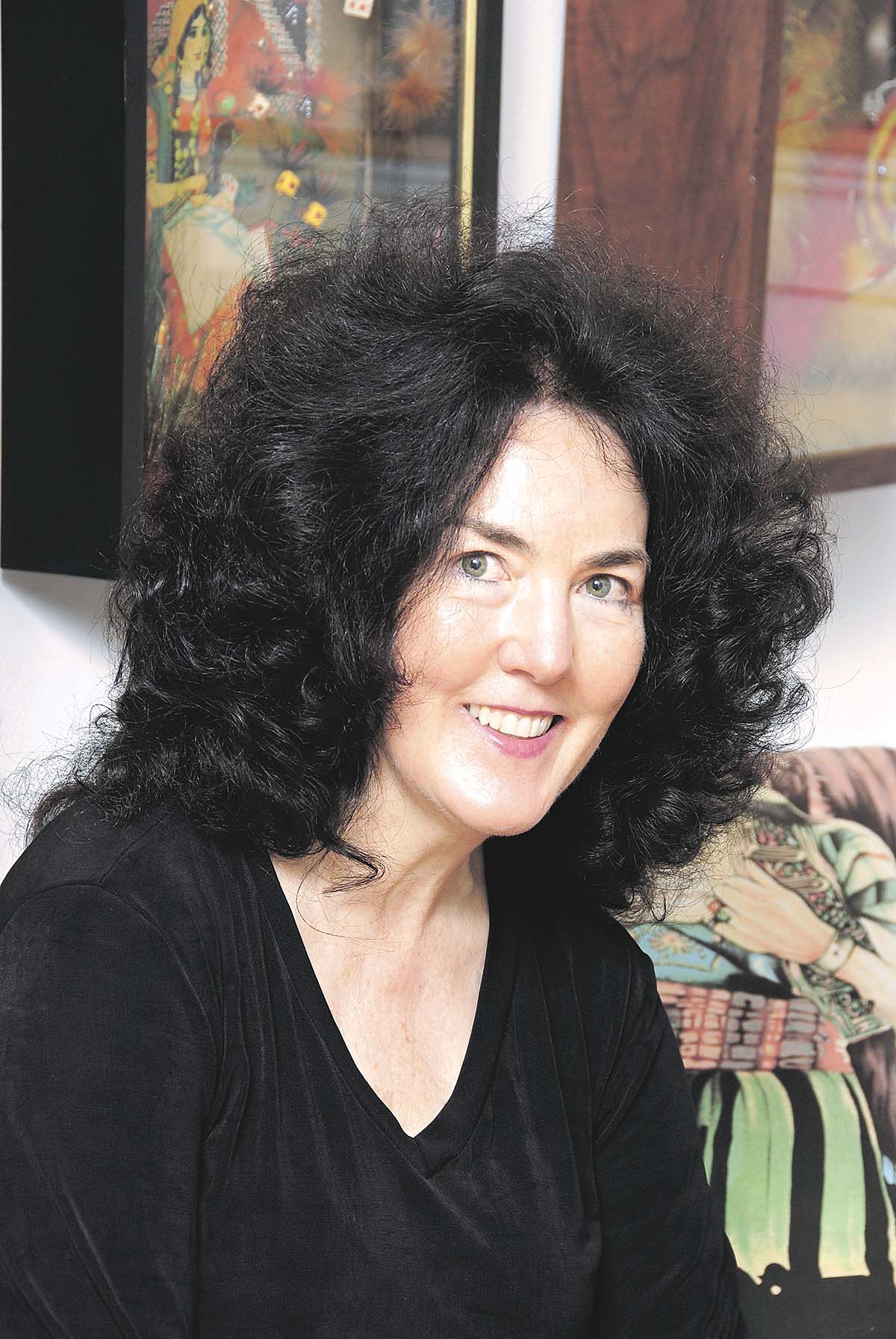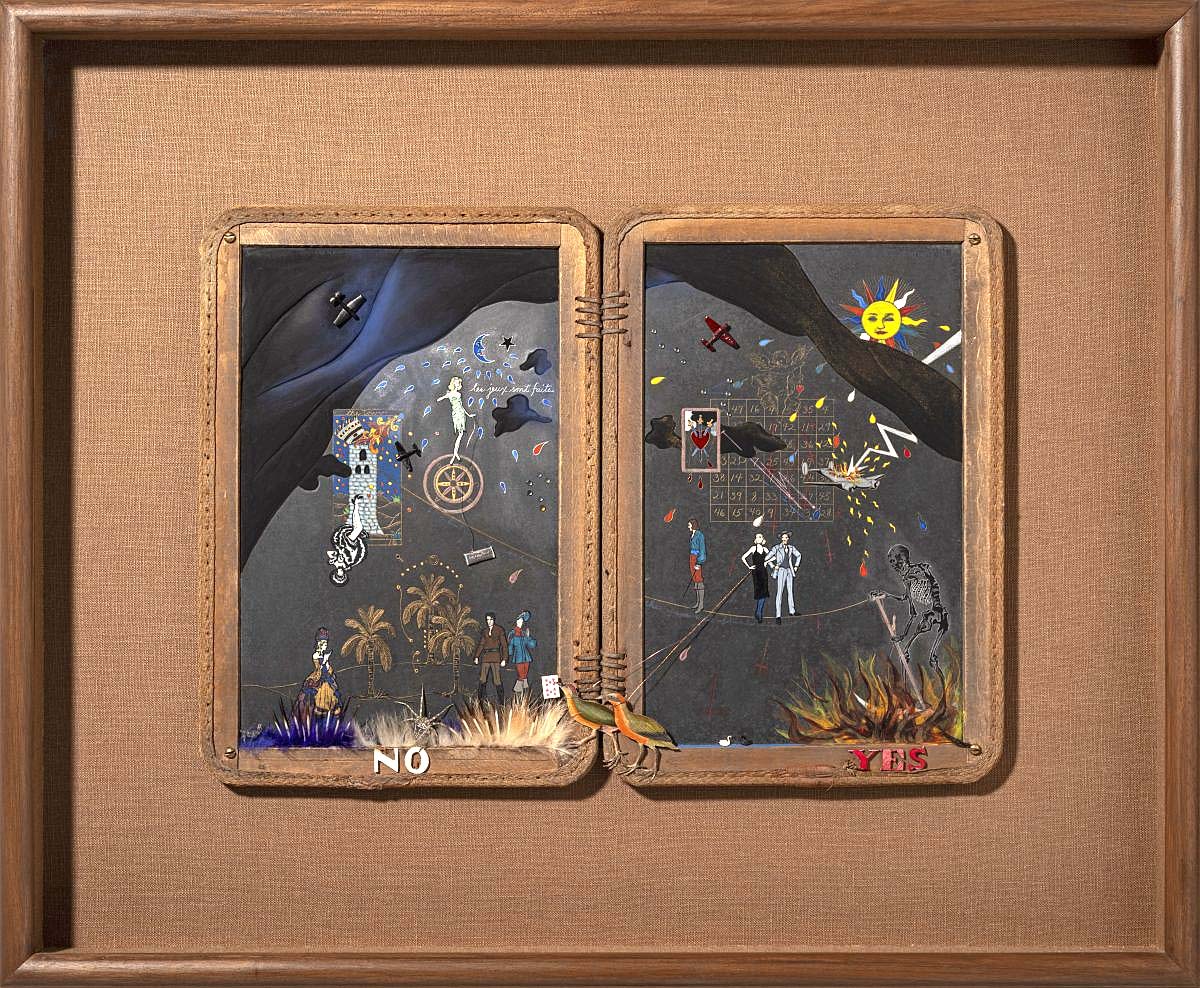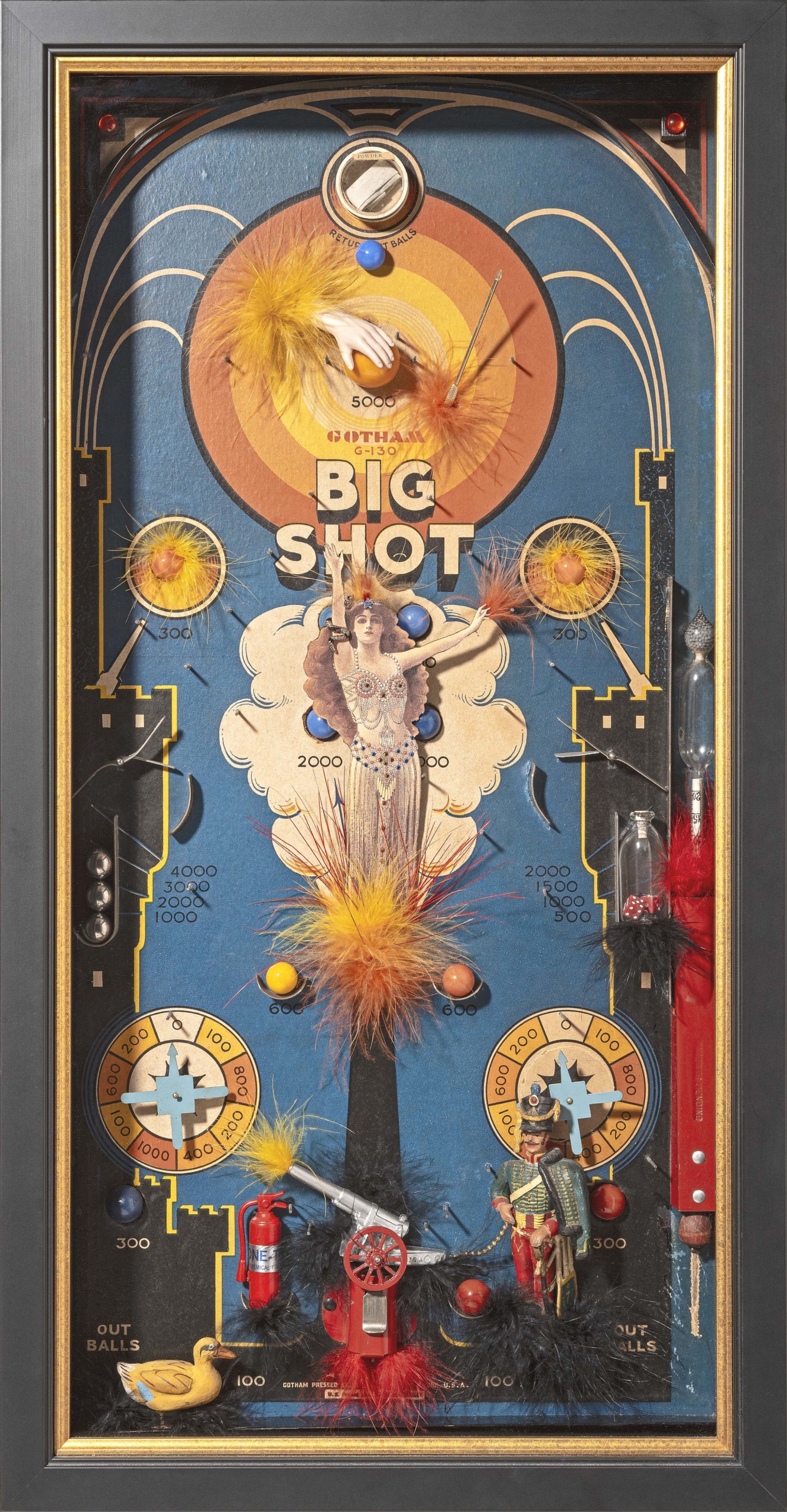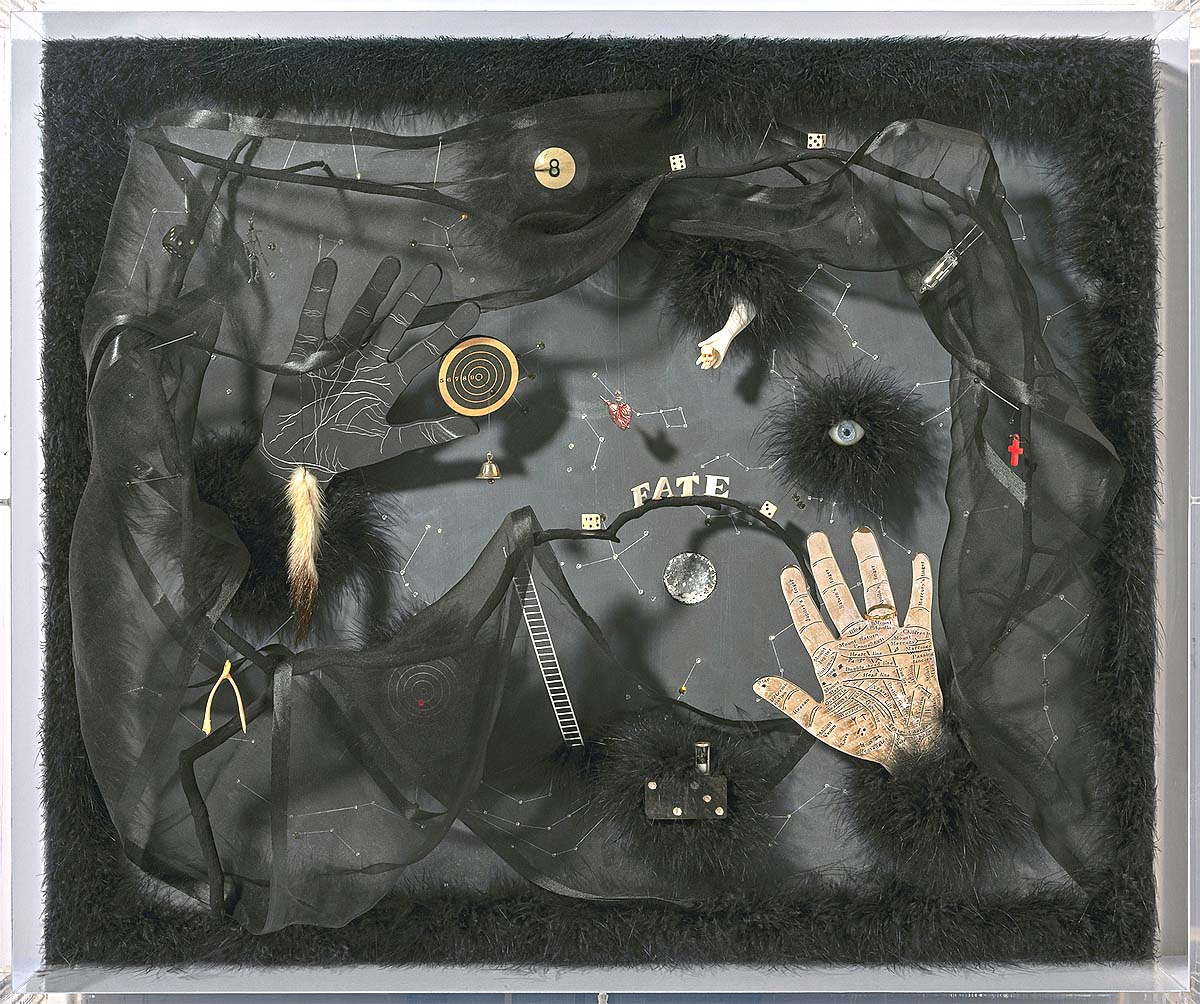
Maureen McCabe is a Connecticut-based collage artist, whose assemblages have been described as “both magical and intellectual.” Her works, which weave together ideals of art history, feminism, magic and mythology, are on view now at the William Benton Museum of Art at the University of Connecticut’s Storrs campus. The 55-year retrospective of her career, “Fate and Magic: The Art of Maureen McCabe,” runs through December 14, and we wanted to learn more from the artist herself!
Congratulations on this career milestone! What does it mean to you to have this retrospective hosted so close to home?
It’s my first major, major retrospective in 50 years. I had one about 20 years ago at the Bellevue Arts Museum (Wash.), but it was nowhere near what this one is. The Benton at the University of Connecticut is our state art museum! The Benton has a long history of doing major exhibitions in the past — really solid work. And, it’s a university, which is special because I taught for 40 years at Connecticut College in New London.
What’s been really exciting for me is I’ve gotten to meet friends there and go to my exhibition and there are so many students that are actually looking at it. I’m considered one of the “original goths,” and they’re still out there. It’s really sweet. They’ll come up to me and say “I’ve seen your exhibition three times, I just can’t tell you how much I love your work.” I’m in my 70s now, and I’m talking to a 17-year-old, that’s a pretty big difference, but I can also understand that because I was always considered different.
The exhibition is also on for a pretty long time, through mid December, so it’s not one of those turnaround things. So, that’s been exciting for me — that people who have actually wanted to see my work for a long time, not only do they get to see it, they get to see 55 years of which they had no idea of the artistic range of the work. I mean, even I hadn’t seen it all together.
A lot of my work is on a secondary market now. I was able to reaquire a major piece, “Le Jeux Sont Faits” in 2015. This was a piece I did in 1978, which became the premise of the show.

Maureen McCabe, “Les Jeux Sont Faits” (1978), mixed media on slate. Courtesy of the artist. Photography credit: Paul Mutino. On display at the William Benton Museum of Art, UConn.
Is this the first time The Benton has hosted your work?
I was part of a feminist exhibition that they did a few years back, and that’s how I actually got to know their curator, Amanda Douberley. A work of mine was given to The Benton, which I didn’t know until she emailed me. I had been in exhibitions at the gallery of the art department at UConn in the 70s, but that gallery doesn’t exist anymore. In that feminist exhibition [“Encounters with the Collection: Celebrating Art by Women,” 2022-24], I was in the “historic room.” It was funny because I was with artists I love, but they’re all dead and I was alive! It’s a really good thing to be alive and see your work put beside some of your favorite women artists.
How did this exhibition come about?
I had all these art dealers and I’ve had scores of shows and then I have all this work and I’m retired now, so it’s kind of like, all right, I have to do something with this. So, I know what my themes are and if you notice what’s going on in a lot of art museums and galleries and libraries, they’re doing the type of work I do. For example, “Conjuring the Spirit World” [at the Peabody Essex Museum, September 2024-February 2025] and there’s going to be a big tarot card show at Yale. The University of Oxford’s Bodleian Libraries had this major show on divination [“Oracles, Omens and Answers,” December 2024-April 2025], so it’s kind of in the air and has a real appeal right now. I’ve been in this, studying this since I was born. I just thought, “I’m going to do this.”
I’ve been thinking about it since I got “Le Jeux Sont Faits” back in 2015. I know the director of The Benton, and you’re not really supposed to do this, but I just asked her, “Would you want to do a show on fate and magic?” If she said she wasn’t interested, it wouldn’t matter because at least I tried. You have to try! I’m 78, I’ve already done a lot of “should haves,” so, I just asked her, and she said to send her a proposal. I worked really hard on that proposal, and I presented it in person. It really came together a lot faster than I expected.
The Benton has gotten a lot of the major pieces back from collectors — “Magicienne” “VOUDOU” and “Amazon Women” — so I was like, “Whoa, I’ve got the stuff.” The Benton’s staff did a great job putting it all together.
Are there any new works in the show?
Oh yeah! My new series is “Circe,” and she’s in there. She’s from 2024. I just finished another piece juxtaposing Fray Wray with Apollo and Daphne, but I didn’t have it done it in time because I was redoing all these other works and helping with the catalog. It was a lot of work. I do have a few pieces from 2020-24, so yeah, there’s a bunch of new pieces from this decade.
What got you into making assemblages like these?
When I was little, I went to Saturday classes at the Boston Museum of Fine Arts. I learned traditional techniques and all that. But I went to RISD in 1965, which was the height of the Pop Art movement, and the boundaries started coming down and when “The Happenings” started with the Vietnam War and the students who were shot at Kent State…
I didn’t start seeing New York things until I went to RISD. And the art coming into museums at that time… You had Andy Warhol and The Velvet Underground — the music scene was unbelievable and combined with art, too. We thought it was normal, but then we realized this would never happen again. It was that kind of movement happening in the world, and it was also happening in the art world in SoHo. That’s where all the younger artists were doing things and the Women’s Movement was happening. This was the time period during which I was forming as an artist. It’s very different now because now you can do absolutely anything.
In 1965, I was a sculpture major, and I was doing figure modeling. I went from sculpture to illustration, but in illustration, I started making these things with fabrics and feathers… There was a Catholic charity shop down the street, and it had all the best stuff, so that’s when I started collecting things and making art with them. I also loved lenticular screens, which were really big then, so I made a whole bunch of those too.
My undergraduate work was all very experimental with materials I could get for nothing. It was clear I was doing something different from everyone else, but I wasn’t really sure what I was doing until I went to graduate school. By that time I had seen Louise Nevelsen and Joseph Cornell and I knew who the German collage people were. I knew the history through art, but there was a lot I didn’t know and I kept learning in school. But, I didn’t have the money for materials and I didn’t have Brimfield until 1971. I never thought I would be in the position to buy what I wanted, but a good job does that. I get my stuff from all over now. I make a lot of the stuff that goes in my work, but I have different sources for other pieces. I have a miniature artist in Paris, so if I want a beautifully painted little fox, I can just text her and ask her to make one. And then I have a miniaturist in Poland who I really like too. For those really perfect little pieces you need somebody with that skill level.

Maureen McCabe, “Blue Ionia” (2013), mixed media on game board. Courtesy of the artist. Photography credit: Paul Mutino. On display at the William Benton Museum of Art, UConn.
From where do you draw inspiration?
Folklore, fairy tales, most of the Nineteenth Century and what people did, and then the Seventeenth Century is my favorite time period because it’s the age of the marvelous. The imaginative level in the Seventeenth Century is just visually unbelievable. And then the pre-Christian passage graves in Ireland, pagan sites or pre religious sites. And I read a lot. It’s based in what I’m interested in. I’m interested in the the spectacular. And I’m friends with magicians. There’s such an overlap in occult magic and magician magic.
I’m a big fan of Leonora Carrington. Her work is supernatural and magical. And, I have to give a shoutout to the pre-Raphaelites. My favorite is John Waterhouse.
Do the objects come first, or do the ideas?
It’s a little of both. I have a list of something like 50 pieces I should be making, and I have the objects to go in those pieces. I have all these objects — some for 35 years or more — just waiting to come together.
For example, I have a miniature Humpty Dumpty patterned wallpaper from a Nineteenth Century dollhouse, and I also have little cards, a Nineteenth Century ceramic Humpty Dumpty and a wall.
I had that wallpaper and I knew I wanted to do something with it. But the time from when I got the wallpaper to when I got the wall and Humpty was 25 years.
I have thousands of little objects. But as I’ve gotten older I have changed my priorities a little. I have great clown objects — I don’t really like clowns, but I do a lot of circus things, so I collected clowns too. I decided I don’t really want to do things with clowns because they freak me out. I have enough to do with what I love. When you’re 78, you’re not going to have a whole lot of time to finish works, so you have to do what you want to do.

Maureen McCabe, “FATE” (1986), mixed media on slate. Courtesy of the artist. Photography credit: Paul Mutino. On display at the William Benton Museum of Art, UConn.
It looks like there are about 15 works by other artists in the exhibition. How are those works in conversation with yours?
The works with mine are from my personal collection. I have an incredible oil painting by my friend Karen Santry, of a woman standing in front of a refrigerator, and it’s totally representational, very much painted like a Vermeer. So, it’s a beautiful painting and the woman is dressed up in an outfit with a veil over her face and she’s got a pet cat. So, it invites you to compare and contrast. My work has women in it and in Santry’s painting, her beautiful woman has her cat like a familiar — in witchcraft, a familiar is an animal that protects you and can warn you. This really is a perfect piece for me to have. I’ve had her piece since the 1980s, and she bought one of my works in 2008, so now she has my best piece and I have hers.
I know Betye Saar, who is another mixed media artist, so we traded works too. If you look at my art, you can see why I’d like theirs and vice versa. Adding these other works was Amanda Douberley’s idea. There’s a movement in museums now to show material culture relating to the artist, so these works I own from other artists fit in that way.
They have a lot of magic-related stuff, not just art works. And they took pictures to show my studio and the way I live and where my work comes from.
—Carly Timpson
[Editor’s note: McCabe will be hosting a lecture, “A Life Conjuring Art and Magic,” at The Benton on All Saints or All Souls Day, Saturday, November 1 from 3-5 pm. RSVP to benton@uconn.edu or 860-486-4520.]




